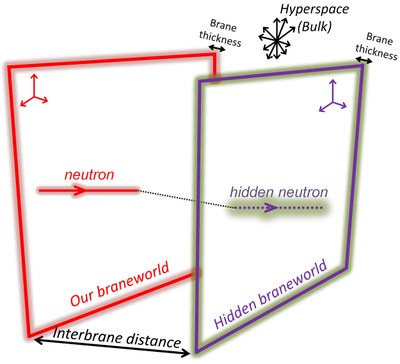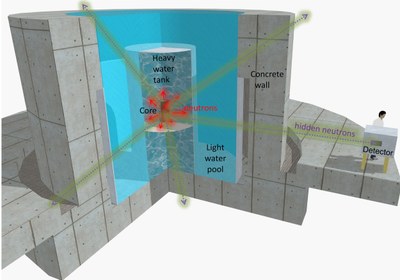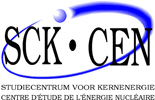The MURMUR experiment: Background
As suggested by several extensions of the standard models of particle physics and cosmology, our visible world could be a 3-brane, embedded in a multidimensional bulk, possibly coexisting with hidden braneworlds.
 In this context, in previous works, we introduced a new theoretical approach to investigate the experimental consequences of the existence of other branes. We demonstrated that, at low energy, fermion quantum dynamics in a universe containing two branes can be reduced to the dynamics in a two-sheeted space-time M4 X Z2 whatever the initial brane model. This result allows for particles swapping between two adjacent branes in the bulk.
In this context, in previous works, we introduced a new theoretical approach to investigate the experimental consequences of the existence of other branes. We demonstrated that, at low energy, fermion quantum dynamics in a universe containing two branes can be reduced to the dynamics in a two-sheeted space-time M4 X Z2 whatever the initial brane model. This result allows for particles swapping between two adjacent branes in the bulk.
In 2015, we proposed an experiment to investigate matter swapping between branes by looking at the reappearance of neutrons from a neighboring brane. In this neutron-passing-through-walls experiment, a very bright source of neutrons and a low-background neutron detector separated by a wall are necessary. Neutrons would swap into a sterile state – the state where they are located in another brane – which would be free to cross the wall. Then, the reappearance of neutrons into the detector situated behind the wall was checked.
More technically, a neutron n could transform into a hidden neutron n’ when colliding with a nucleus. From a practical point of view, each collision at a nucleus acts as a quantum measurement and the neutron is reduced either in our, visible, world or in the other, invisible, braneworld (to become a hidden neutron) with a probability p. Hidden neutrons could, therefore, be generated in the moderator medium of a nuclear reactor, where a high flux of neutrons undergoes many elastic collisions. Being located in another braneworld, these hidden neutrons would interact very weakly with matter and freely escape the reactor. However, the reverse swapping process would permit us to detect them – with efficiency also proportional to p – using a usual neutron detector located close to the reactor. The disappearance and reappearance of neutrons due to the swapping between braneworlds would lead to the possibility of neutrons passing through a wall.
 After a first experiment in 2015 at the Institut Laue-Langevin (ILL) in Grenoble (France), we extracted the upper limit p < 4.6 × 10 −10 at 95% C.L.. Although we measured a nonzero neutron rate, it must not be considered evidence for hidden neutrons. Indeed, we cannot exclude neutrons leaking through the shielding or secondary particle creation in the device. The residual counting rate was too low to identify the origin of these events precisely. To understand these events, a longer acquisition time would be necessary, as well as measurements with reactor off, in addition to specific simulations. This issue will be considered in the present project MURMUR with the main purpose consisting into a significant improvement of the upper limit on the swapping probability p.
After a first experiment in 2015 at the Institut Laue-Langevin (ILL) in Grenoble (France), we extracted the upper limit p < 4.6 × 10 −10 at 95% C.L.. Although we measured a nonzero neutron rate, it must not be considered evidence for hidden neutrons. Indeed, we cannot exclude neutrons leaking through the shielding or secondary particle creation in the device. The residual counting rate was too low to identify the origin of these events precisely. To understand these events, a longer acquisition time would be necessary, as well as measurements with reactor off, in addition to specific simulations. This issue will be considered in the present project MURMUR with the main purpose consisting into a significant improvement of the upper limit on the swapping probability p.
The required skills for this work are the same as for our first experiment. As a consequence, this work takes place in the continuity of the collaborations between the PMR at the University of Namur (Belgium) and the LPSC at the Université Grenoble-Alpes (France). But now, instead of considering the ILL reactor, the BR2 reactor of the SCK·CEN (Mol, Belgium) is under consideration.
While UNamur remains the main contributor to the device building and data analysis, LPSC will be responsible for the main computations about hidden neutron diffusion and will contribute to data analysis. Now, SCK·CEN will provide access to BR2 reactor. In addition, the “reactor physics BR2” group of SCK·CEN will ensure neutron flux computations inside the BR2 reactor, needed for LPSC computations.






